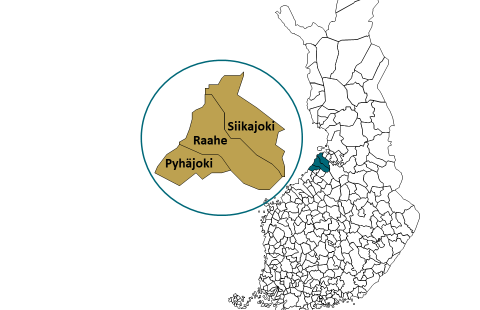Raahe subregion
Raahe subregion
Strengths in environment, clean energy and logistics advantages
In addition to exceptionally strong expertise in the metal industry, Raahe region is proud of investing in the circular economy and environmentally friendly industry. The area is among Finland's top producers of wind power, and the growth continues. The 20 wind farms that are currently being planned could accommodate nearly 300 new power plants. The demand for clean energy is huge, as the hydrogen economy in the region is facing very high expectations. The renewal of SSAB's steel plant in Raahe, which aims at fossil-free steel production, is a significant investment in the region.
The magnificent nature and true gems, such as the archipelago and Old Town Raahe, are the highlights of tourism in the region. The Raahe region is part of the Pohjola Route, and the local tourism industry is undergoing major development. Reaching the Raahe region is easy as National road 8 takes you to the Oulunsalo Airport in an hour, and getting to Raahe train station in Vihanti on the main road 88 takes half that time. In addition to streamlined road traffic, the port of Raahe serves the needs of companies and also has an electrified railway line. The port has made significant investments in even larger project transports, and it is one of the busiest ports in Finland.
Jobs and training
The number of jobs in the region is around 8,500, of which almost 3,500 are in industry, while the second largest number of jobs - around 2,000 - are in the health and social services sector. Approximately 1,000 people work in the wholesale, retail and construction sectors.
Workplace self-sufficiency has been more than 100% in the Raahe region throughout the 2000s, and at its peak, almost 120% in Raahe. Approximately 2,400 commuters from Oulu, Liminka, Kalajoki and other localities work in the Raahe region, while 1,500 commuters work elsewhere in the region.
Raahe region has very strong upper secondary education, and the number of graduates is well above the average in Finland. In recent years, the multi-campus model, which has received national attention, has helped to increase higher education in the region.
Measured by the number of establishments, the largest sectors in the Raahe sub-region are agriculture, wholesale and retail, and construction. The total turnover of businesses was approximately EUR 1.7 billion in 2020. Looking at added value, the metal industry is by far the largest of the sectors at a turnover of EUR 250 million.
Entrepreneurship in Raahe region
The net sum of companies founded in the Raahe region has been positive for a long time, excluding a couple of exceptional years. Over the past few years, an average of 110 companies have been established each year and about 90 companies have closed down. Of the 2,300 companies in the region, 95% are micro-enterprises employing 1–9 people and 4% are SMEs. Importing and exporting companies in the region account for around 4%.
Raahe Region Development measures annually the short-term views of companies on the basis of a business barometer conducted as telephone interviews. The overview helps to direct services aimed at companies and produces up-to-date information for regional decision-makers.

